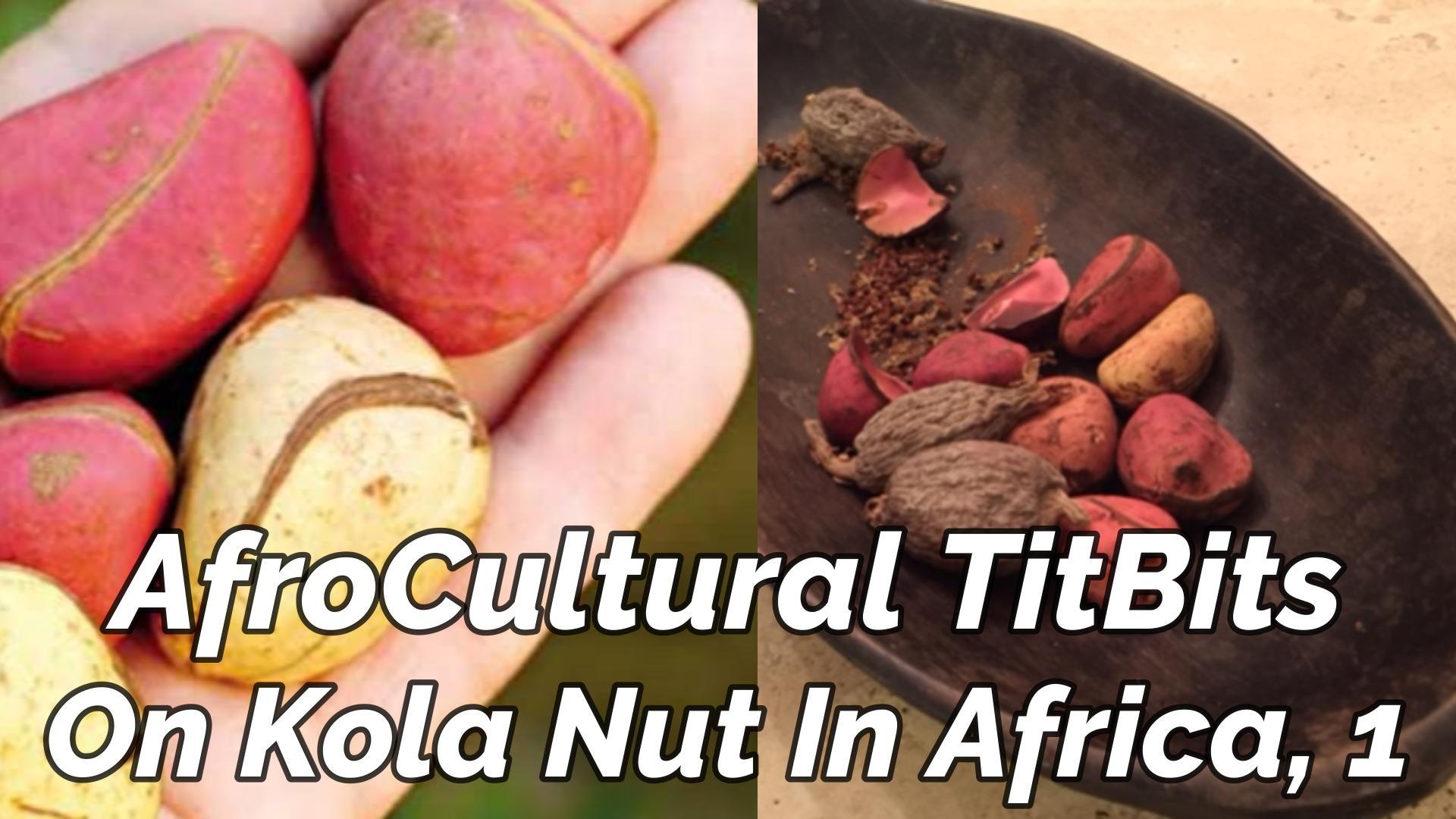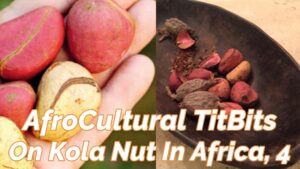June 30, 2022
THE ‘HOLY-COMMUNION’ FRUIT OF AFRICA
Greetings, folks, and welcome to the premiere of No Bullshitting Blog’s (NBB’s) “AfroCultural TitBits” Series. And, what better way to start, than the introduction of a Holy-Communion ‘Bread’ of Africa, the Kola-Nut. Umm huh! You’d better believe that I am not frivolous with my use of ‘Holy-Communion.’ I don’t mean to take anything away from the essence of the Holy Communion custom of Christians, which was initiated by Christ himself. But, yes, that’s what kola nut is to the Igbo people of West Africa—Holy-Communion Nut! You will understand the origin of this Communion-Value, the history, and its entire essence, on the kola-nut miniseries, on NBB.
We are presently only sure about this custom among the Igbo people of southeast Nigeria. We shall investigate its spread. Is it just an Igbo custom, or do other tribes of Nigeria have something similar? If not exactly with kola nuts; do other tribes have similar custom, with different fruits or nuts as the icon, or whatever? Is the custom found in other West African nations, or African nations beyond the western region?
Meanwhile, I will give you a basic introduction of Kola Nut. It is the product of Kola Tree, which is indigenous to, and common in West Africa. It contains various valuable properties, including antioxidants, and lots of caffeine. Here are pictorial samples of kola nut tree, kola nut fruit or pod, and kola nuts:
I have introduced the new NBB “AfroCultural TitBits” Series. I have also introduced the premiere topic of a very important cultural value of kola nut among the Igbo people of Nigeria. And now, I bring you our AfroCultural-Traditionalist, the dude who is in charge of the category. His pseudonym for this is, “Udoakpuenyi.” He has his reason to keep his real name away for now. Maybe he will announce it to us with a fanfare, at his right time. Anyway, since this is AfroCultural forum, I might as well explain the meaning of our man’s African nickname. “UdoAkpuEnyi” is Igbo language phrase for, “Rope cannot drag an elephant.” Umm huh, it is difficult, or downright impossible to tether and/or drag an elephant with an ordinary rope. Of course, that’s in the traditional sense of rope, when rope was only made out of tree-barks and what-have-you. I’m sure that an elephant cannot break a rope that is made out of steel.
Once upon a blog, I discussed the fact that most, if not all African vernacular names, are sentences, or at least phrases. This is another in my pool of examples. For illustration, I capitalize the letters that start the three words that comprise the “word,” UdoAkpuEnyi. Otherwise, it is normally written as Udoakpuenyi, a single word. ‘Udo’ means ‘rope,’ akpu,’ means ‘can’t drag’ (another compound word within a compound-word). And ‘enyi’ is elephant.
Okay now, enough of the deviation from the ‘chase.’ Let’s cut to the chase. And the ‘chase’ is Udoakpuenyi’s premiere edition of NBB’s AfroCultural TitBits. It features the Kola Nut, and its “Holy-Communion” Cultural Values for the Igbo people of southeast Nigeria.
KOLA NUT, THE “HOLY-COMMUNION” ‘BREAD’ OF THE IGBO RACE OF NIGERIA
EDITION 1, BY UDOAKPUENYI
In this first edition of AfroCultural TitBits on No Bullshitting, we will be serving you with kola nuts. It is customary in Africa, especially in Igbo land in Nigeria. It is deliberate to choose this topic as our starter, because kola nuts are the first things that are served to a visitor in parts of Africa. It is a cultural sign of acceptance and welcome. So, I officially welcome you to the first edition of No Bullshitting Cultural experience.
Kola nut is a fruit of the kola tree, which is known botanically as Cola acuminata and Cola nitida. It is commonly found in West Africa. The nuts come from a tall tree of about 40 to 60 feet height that produces pods of kola nuts. Each pod contains five to six big seeds inside. Each seed can be broken into smaller parts that are loosely glued together, thus:
Nutritionists claim that kola nut contains 2 to 3 percent caffeine, and 1 to 2 percent theobromine which are stimulants. Kola nuts taste bitter when eaten.
But the story you are about to read is way beyond the face-value or nutritional-values of this tree. It is more about it’s cultural value to Ndị Igbo (Igbo people) of Nigeria. But before we get to that, a general introduction is in order here. The Igbo people call it, “ọji.” Yoruba language calls it “obi awe.” Edo people call it “Evbe.” And it has different names for different other peoples of Nigeria. Kola nuts remain the most widely sold fruits in Nigeria, especially in the poor neighbourhoods. It is eaten by all, and revered by some.
Kola nut tree grows largely in Western Nigeria, in commercial quantity. But it is enjoyed in every part of the country and eaten almost like food in the North without ceremonies.
Kola nut is a uniting factor in Nigeria. It is known for its cultural diversity with over 250 tribes. The fondness of kola nuts as a fruit, cuts across ethnic and religious divides, in this highly sensitive boiling pot of cultures called Nigeria.
The Igbo tribe of the South East Nigeria celebrates the kola nut more than anywhere on the continent. The nut is highly valued and respected in this region. It is interwoven in the social, cultural and religious fabric of the people. Yet, kola nuts are not produced in large quantity in the region. We shall expatiate on the cultural values in due course.
TYPES OF KOLA NUT: Before I bore you with this long introduction, let’s quickly note that there are two types of kola nuts. But we will be concentrating on one known as cola acuminata, which is red. This species breaks into several parts. I will tell you the significance of this to the Igbo people and their culture, soon.
The most common type is known as cola nitida which breaks up into two large parts. It is mainly light yellow. This colour leaves some pigmentation in the mouth and teeth of the consumer.
SIGNIFICANCE OF KOLA NUTS IN IGBO TRADITION: Kola nut is very significant in Igbo culture. It is the first thing that is served in every home during a visit. It is so important that every home keeps it handy at all times, to receive visitors. Any home that does not present kola nuts to a visitor, shows or has an implication that the visitor is not welcome. It does not matter if the family gives the visitor the most priced gifts around. Without the very first required ritual of offering and breaking of kola nut, the family has not really welcomed the visitor. Commonly, the visitor may go away with those “priced” gifts, and still complains that the host did not serve him or her kola nuts. Naturally, this is strange to a none Igbo person. You may wonder how a simple kola nut of less than ten cents can be more valuable to any sane person, than a hundred-dollar gift. That’s strong cultural value for you!
The host presents kola nuts to the guest(s); the host says traditional prayers, and incantation sometimes. Then the host breaks and shares the kola nuts to everyone present, to partake in the consumption ritual. That is the “Holy Communion” that we talk about. Mind you, it does not really matter whether the visitor(s) eats the nuts or not. If he/she does not eat it, he/she must partake in the prayer and the blessings. And after the blessings, the person simply touches the plate in which the kola is being passed around, as it makes the round to the next persons.
So, kola nut is not just a nut to the Igbo people. It comes with a lot of deep spiritual significance. It also serves as an object of memory. It ensures that the subject matter of that trip goes beyond the trip, to the home of the visitors. This comes with a tradition, whereby one whole kola nut, or more, are given to the visitors, to take home from the trip. The idea is in the saying that, “Oji ruo ụlọ, o kwuo ebe osi bia.” This means, “When kola nut reaches home, it traces its origin. Like, “Honey, those are some kola nuts that were offered to me by Chief Udenta, yesterday.” Other gift items may do it, sort-off, but without the blessings that go with the kola nuts.
Again, kola nuts provide the opportunity for communion, togetherness, fellowship, friendship, intimacy and acceptance. Beyond homes, it is used in welcoming guests during ceremonies and parties. It is also used to declare a meeting or conference open to commence. Yes indeed, it can be likened to the Holy Communion or Holy Eucharist of the catholic faith. Both rituals are observed during spiritual commune with God. It is said that, “Onye wetere oji wetere ndụ.” This means, “He/she who brings kola nuts, brings life.”
Here is the major difference between the Christian Communion and the Igbo traditional Kola Nut Communion: The Christian Communion priests pray through Jesus Christ before the bread is broken. The Igbo traditionalists pray to the same Almighty God, but through the spirits of our Pius Forefathers. It must be served and blessed with a lot of incantations, laced with proverbs.
COMING NEXT ON THE SERIES: Kola nut has a lot of rules guiding its usage in Igbo land, in southeast Nigeria. Breaking any of the rules nullifies the iconic essence of the custom. It is believed that each of the parts goes with the blessings that are sought from God, through the spirits of our Pius Forefathers.
Follow us, as we take you through the ‘Dos’ and the ‘Don’ts’ of kola nuts in Igbo land, in our next edition.
By Udoakpuenyi…
Contributory editing by Harry Agina





Pingback: AFROCULTURAL TITBIT ON “KOLA-NUT” IN AFRICA, 2 -